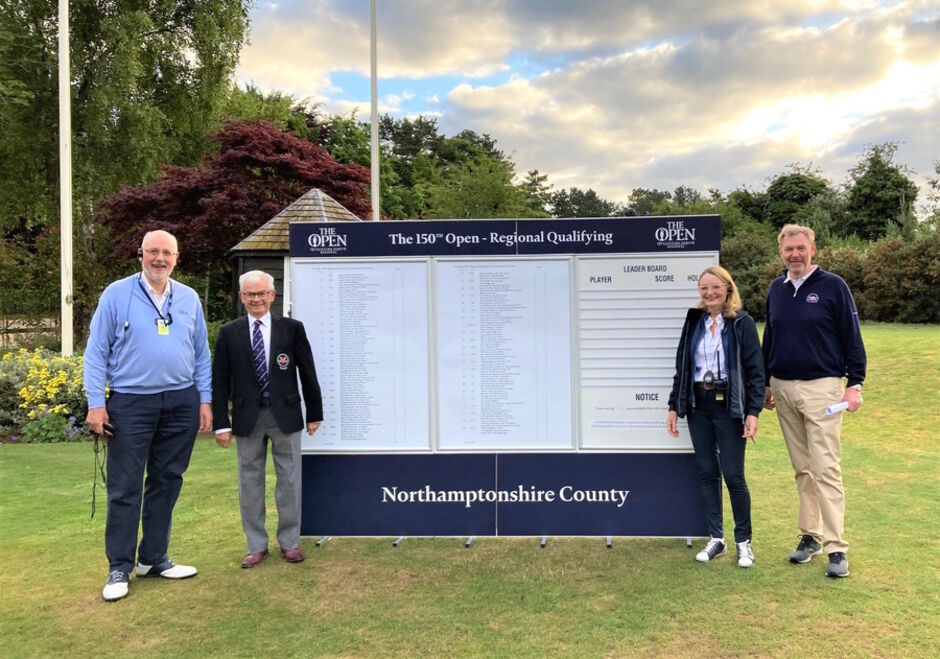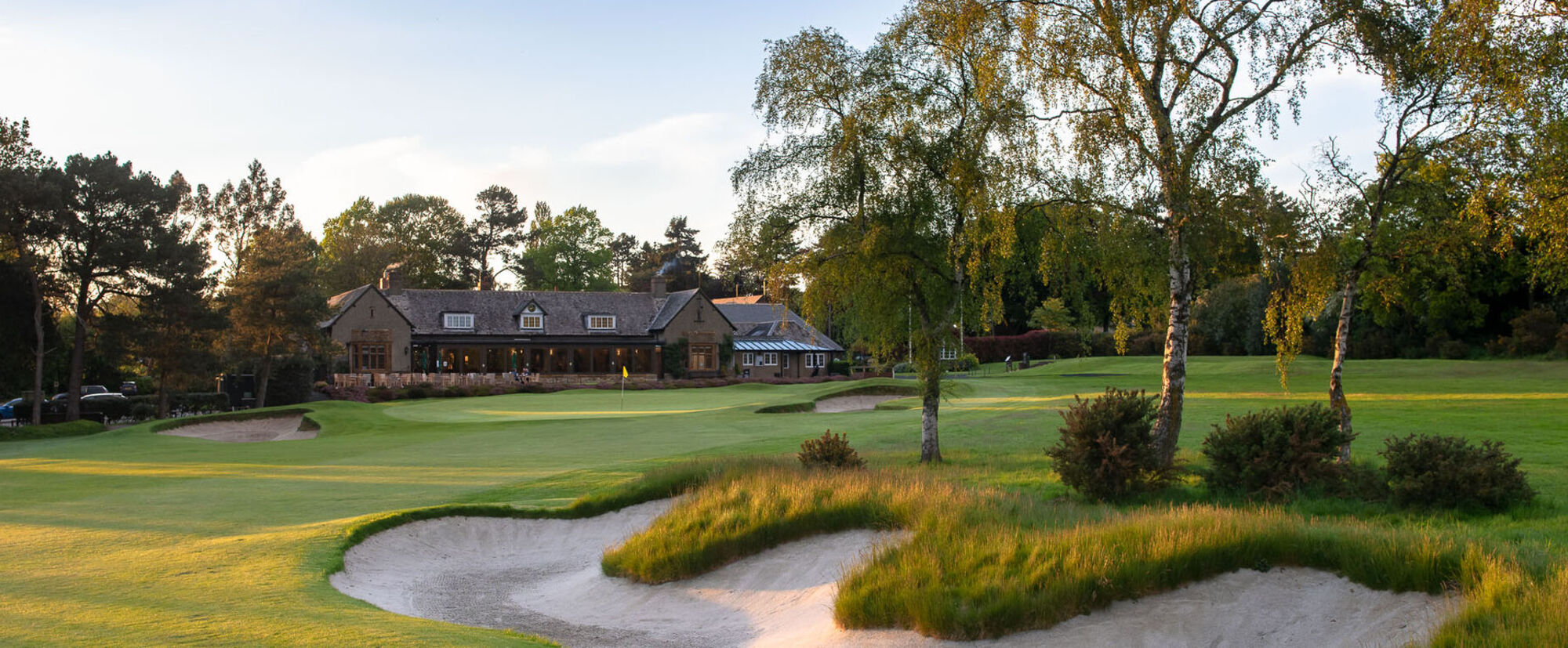
Course History
The finest golf course architect
Construction of the Northamptonshire County Golf Course began in April 1909 and the course was opened for play the following year.
The original 18 holes were designed by the distinguished golf course architect, Harry S Colt, who also designed Wentworth and Sunningdale. The course has stood the test of time very well as relatively few major alterations have been made to it since; the most notable of which were carried out by James Braid, in 1947, when the pattern and arrangement of many bunkers were altered and the 18th. green was relocated to its present position in front of the clubhouse.
A further 3 splendid holes designed by top course architect, Cameron Sinclair, were opened in May 2004. These now provide a 9 hole loop returning to the clubhouse, for those wishing to play 9 or 27 holes.
The 6 hole, Par 3 Colt Course was added in 2008. It is constructed using the latest Synthetic Putting Surfaces to give year round consistency to those wishing to hone their Pitching, Chipping and Putting skills.
In 2005 a major review was initiated with the objectives of bringing the course in line with modern requirements as a sound test of golf, to provide a greater challenge and enjoyment for members, without creating insurmountable obstacles and to enhance its standing nationally. The plan formulated included lengthening the course, when played from the back tees, to approximately 6750 yards but maintaining the existing length from the yellow tees. New bunkering largely creates a need for more thought and care when playing from the tee but some other changes will make the course less forbidding to the shorter hitter, for example the entrance to the 6th green and extending the cut area at the 2nd nearer to the tee. This work was also undertaken by Cameron Sinclair and completed over 2 successive winters from 2006/7.
Prestige
The course is a traditional heathland golf course with undulating woodland, gorse, heather and fine pine woods.
In recent years Northamptonshire County Golf Club has been the venue for many National amateur golfing competitions including the English Schools National Championships (1997), English Golf Union Carris Trophy (1994) and the British Girls Open Tournament (1992).
In addition, for 6 years from 1997 until 2002, the course was the home of the Regional Qualifying for the Open Championship. We are to become a Regional Qualifying course for the Open Championship again in 2018. The final of the EGU Club Team Championship was played over the Brampton course in 2002 and in 2004 the ELGA Closed Championship was held here. In May 2007 and through to 2013 we have hosted the prestigious PGA Seniors Professional Championship, a three day event, and despite the high quality fields only a handful of rounds below par were recorded in any year.
Course Architects
Profiles of our course architects Harry Colt, James Braid and Cameron Sinclair.
Northamptonshire County Golf Course was designed by Harry S Colt in 1909. Construction work began in April 1909 and the course was opened for play the following year. It has stood the test of time as major modifications were only made in 1947 when James Braid altered the bunker layout and repositioned the 18th. green to its current position.
Harry Shapland Colt
Born: 4th August 1869 - Highgate Died: 21st November 1951 - East Hendred, Berkshire
Educated: Monkton Combe School 1881 – 1887, Clare College, Cambridge 1887 - 1890
Sport: At school he was a Prefect and Captained the Cricket 1st XI and Rugby 1st XV. Member of the 1st Four Stroke (Rowing) and Tennis Double Champion 1884-86. Athletics champion 2nd Division 1885.
Clare College, Cambridge: Studied Law BA in 1890. 2nd Class in special examination leading to an ordinary degree in law. Captained Cambridge University Golf Team in 1890.
Sporting Achievements:
Won R&A Jubilee Vase in 1891 and 1893.
1908 selected to play for England v Scotland at golf.
Appointed a partner in the Hastings Law Firm of Sayer & Colt in 1894, during which time he helped design the Rye Golf Course and became its Honorary Secretary in 1895. In 1897 he became a Founder Member of the Royal & Ancient Rules of Golf Committee.
Golf, having been his primary interest and a frequent competitor, it was no surprise when in 1901 he applied for the job of Secretary at the new Sunningdale Club with some 400 plus other applicants. In July, he was elected at a salary of £150 per annum.
It was from this base that he gradually developed his interest and ultimate career as a golf course architect. Suffice it to record that Harry Colt, together with his partners Charles Alison, John Morrison, and for a few earlier years Dr Alister MacKenzie, were involved in the design, construction, and remodelling of over 300 courses world-wide including the Eden Course at St Andrews, Royal Portrush in Ireland, Pine Valley and Augusta in the USA. Colt himself being responsible for 115 of these courses.
The complete list can be seen on the Colt Association website - www.coltassociation.co.uk. It is of interest that the British Open Championship has been played on a Colt designed or remodelled course no less than 47 times since 1910.
In 1928, Colt formed the firm of Colt, Alison and Morrison Ltd, where he remained as Managing Director until his retirement in 1945.
Colt was a bold designer who built strategic rather than punitive courses that were adapted to the stronger playing character of the then modern rubber-core Haskell ball. His greens, as was standard for the day, were built to facilitate surface drainage and were designed for speeds that today would measure 4-6 on the Stimpmeter. He was also a pioneer in terms of master-planning golf courses as part of residential areas. The Detroit CC, in the USA, flows seamlessly in the middle of graceful Tudor estates that frame the grounds. And Colt's St. George's Hill CC (1913), in England, originally a 36-hole complex, now 27 holes, was prototype of the modern country club estate development project.
Bernard Darwin wrote in the Times after covering the 1951 Open at Royal Portrush, in Ireland, that: "It is truly magnificent and Mr. H.S. Colt, who designed it in its present form, has thereby built himself a monument more enduring than brass." In the 1952 History of Golf in Great Britain, Sir Guy Campbell wrote: "The Eden course at St. Andrews, in Scotland, is a monument to the genius of H.S. Colt. True, there was good golfing ground, but there was also much that, at a cursory glance, appeared highly unsuitable - flat, featureless, sodden and at one end arbitrarily constricted. Yet out of this he contrived a links of character, great interest and wide variety, that not only provides an annual test of searching severity, but maintains year by year an undisputed popularity among golfers of both sexes and all ages and handicaps."
Colt was a modest and unobtrusive figure who, in a comparatively short time, probably made a greater contribution to the game than any other single individual, and in doing so, altered the landscape of Britain and other countries around the world to an extent which has not been fully realised until recently.
Harry Colt might be described as the founder of golf course architecture in the British Isles. Golf obviously existed before he came along, but it was a game of straight lines and sharp angles. He softened those lines, introduced curves, and long before the art of pacing courses came into being, created visual challenges to tease and intrigue the golfer. Above all, he was the first to appreciate how golf could be a delightful walk through beautiful vistas.
Colt was a lawyer by training, but during his time at Cambridge enjoyed success at this relatively new game - he was Captain of the University side in 1889 - and soon left chambers behind to pursue a life in the game. He was one of the founders of Rye Golf Club in East Sussex, his first employment in chambers having been at Hastings. It was he who laid the course out there through the Camber sandhills and sparked a fascination for turning rugged landscapes into golfing treasures.
After being honorary secretary there for a few years, he became the first secretary at the new Sunningdale Golf Club, which had opened up at the turn of the century with a Willie Park Jnr course. But design was his love and passion, and after nine increasingly absent years on different projects, he finally set forth on a life as a full time golf architect just before the First World War.
Colt principally concentrated his efforts in the UK, his time almost equally divided between new commissions and revising existing, but rather ordinary golfing layouts. By the time he had finished, he had left his mark in part or in whole on some 300 of Britain's most cherished courses. At the seaside in addition to Rye, he gave us Royal Lytham & St Annes, Royal Portrush, Co Sligo and much of the character and current layout of the Honourable Company's pride & joy at Muirfield. Inland we have those jewels of the Surrey & Berkshire sand belt, the New Course at Sunningdale, Swinley Forest and Wentworth, plus many others throughout the Home Counties, such as Stoke Poges, Denham, Beaconsfield and Camberley Heath. The pick from other parts of Great Britain would have been Royal Worlington in Suffolk , Northamptonshire County and Royal Belfast. He also left his mark on the Continent with those gems at St Germain, just outside Paris, Pedrena in Northern Spain and Kennemar in Holland.
As his renown grew, so he was asked to travel to many parts of the world, but usually chose to send his able lieutenants. Hugh Alison would work extensively in North America, but is perhaps best known for laying out the first courses in Japan. J.S.F. Morrison would carry the company's banner into Continental Europe. And when a call came for some help way down in Australia in the mid 1920s, he sent his newest associate, Alastair Mackenzie. Mackenzie built his reputation in the sandy wastes to the south of Melbourne, and went on to glory at Cypress Point in California, and finally Augusta, with the great Bobby Jones.
The Colt Oeuvre
By Bruce Critchley
Harry Colt came to golf just as it was taking its first tentative steps away from its seaside origins. At that point, what had worked so wonderfully well through uneven dunes round Britain's shores most certainly didn't when taken to the gentle rolling plains of inland England. The few attempts man made at putting features into bland parkland were mostly coarse and ugly; early inland golf tended to scar its environment, not enhance it.
Colt grew up inland, and even when becoming proficient while at Cambridge, might only have come across the true delights of the links with undergraduate sides travelling to matches on the great seaside courses. Certainly he must have encountered links golf at some point, as his first attempt at course creation was on the Camber sands to the east of Rye, near the Sussex/Kent border. And what a start!
After helping found the Club, and being its first secretary during the closing years of the 19th century, Colt moved to Sunningdale as their first secretary in 1901. It was there he discovered that conditions did exist inland that were ideal for golf, heath land. And the good news about the heath is that it had little other practical use.
The soil is similar to that found by the sea. Acid, with fine powdery sand, and the same grasses that work so well on the links, thrive inland. At Sunningdale Colt came across a superb early example of what could be done with that type of ground. The Old Course was Sunningdale's original layout and put there by Willie Park Jnr, himself twice a winner of the Open Championship in the late 1890's.
As Colt evolved from management to architecture his abiding principal became enhancement of the countryside into which he put his courses. They must blend in with, not be imposed upon, their environment. Only then could they 'live' with their surroundings, grow to be a part of them, and so survive the passage of time, and the evolution of the game. They would become 'a lasting record of his craft and his love for his work.'
Much of Colt's philosophy on course design has been left to Charles Alison to put down on paper. Alison learnt his trade at Colt's knee and later became, along with John S F Morrison and Alister MacKenzie, a partner in the business. Obviously a fair amount of Colt's early work involved upgrading existing layouts and Alison vividly describes the conditions he found, particularly inland.
'There was only one form of bunker. It consisted of a rampart of sods with a trench in front, filled with a sticky substance, usually dark red in colour. The face of the rampart was perpendicular. It was precisely 3ft 6ins in height, and ran at right angles to the direction of the hole. The number of such obstacles varied only according to the length and bogey (par) of the hole. Thus a short hole required one, a drive and approach shot two, and a long hole three.'
'Another notable feature of suburban golf was the flatness of the terrain, particularly the approaches to the greens. Very seldom was a green placed in such a position as to render the approach play naturally or visibly interesting, while to create grass slopes or hollows artificially was an unknown art.'
'The fairways were invariably rectangular, the putting greens square and flat. No attempt was made to put undulations into the greens, indeed clubs with resources flattened them like bowling greens or cricket pitches, the poorer ones apologising to guests when theirs were somewhat uneven.'
In short, inland courses from the Victorian era had made little or no attempt to draw on the wonderful legacy of the links. Everything was flat and square and Colt saw it as his primary task to work with angles and bends, slopes and undulations - the curves of nature - and to make courses appear part of the existing countryside. His creed might be found in the words of James Braid, who said of his work at Gleneagles, 'God laid this course out, I only found it.'
So from courses that laid waste their surroundings, Colt introduced those that worked in with their natural environment. He, along with his contemporaries of the day, Herbert Fowler and J F Abercromby, really did use Britain's links heritage as the blue print of their work. In their hands bunkers ceased to be 'no man shall pass' barriers, but were sited so as to capture crooked shots and were to be found around the fringes of fairway and green.
There was usually trouble in front of most tees, but only so much as to punish the topped or miss hit shot. A well struck shot by even the shortest hitters should be allowed to find the fairway. Accuracy was to be rewarded and golf turned into a fun examination for all standards of player. The dogleg became a feature under these early 20th century designers, and doglegs that often asked the golfer to work out how much of the corner he might cut off.
Bunkering became not just a means of punishing the crooked shot, but also a hazard for the better player to cross in search of advantage over the lesser man, to whom he may well be conceding a shot. Small, well sited collections of bunkers were to be found set at an angle to the tee shot, so the longer the hitter, the more of the corner he might try and cut off. In this and so many other ways Colt and his like started to introduce intellectual puzzles into the game, adding interest to what was also becoming a more beautiful walk.
Unquestionably, bunkers were in all instances hazards; go into them and the first pre-requisite was to get out and in those days that meant the niblick. In the mind of the designer, straying from the straight and narrow should cost a shot. Only great skill later in the hole might make amends for the earlier mistake.
The shape and style of bunkers differed from one designer to another. Colt, perhaps staying closer to what he saw at the sea side, favoured the deep 'pot', small in overall size, but deep enough that just getting out required the right technique and not a little skill. The best example of his bunkering is probably to be found at Royal Lytham & St Annes, lots of bunkers and most of them deep.
Alister MacKenzie favoured great flashes of sand, bold statements that immediately caught the eye. His courses would have fewer bunkers, but would cause just as many problems. The most concentrated collection of his work is to be found in that fine stretch of golfing country, the Melbourne sandbelt. Here you will find a handful of the best courses in the world. His most famous though, and a fine example of his style, is Augusta National. Alison himself would be somewhere in between Colt and MacKenzie, but all three saw bunkers as punishment for error, not the shallow splash pits that so many modern designers now favour.
Colt and his colleagues had a few simple dictums. The early holes should ease you into the round; nothing too demanding at the start. Ideally, every club in the bag should be used, regardless of skill. The routing of the course would be determined by the land, and there would be no hard and fast rule about the numbers of par threes or fives on any given nine.
Colt had no peer as a designer of short holes. Both Rye and the New Course at Sunningdale have five apiece and it is harder to imagine a better set anywhere. On both courses they vary from less than 150 yards to just over 200, again requiring all manner of clubs depending on the direction and strength of the wind. In addition, the 7th at the Stoke Poges course (now Stoke Park Club), Colt's first truly solo effort at course design, became the inspiration for Augusta's infamous 12th at the centre of Amen Corner.
Looking around at the legacy of Colt and his generation, one is struck by the wonderful mastery of scale; small greens at the end of winding, narrow fairways reached from tees set back behind a meaningful, but not too daunting collar of rough; each hole an entity in itself, a country lane wandering through a picturesque setting.
James Braid
http://www.thebraidsociety.com/
Born Earlsferry, Scotland, Braid is remembered as one of golf's original and great champions, course designers and modernisers. Braid grew up in Fife - the birthplace of golf. Although his parents had no enthuasism for the game, his cousins were top golfers. His earliest recollection of golf was playing with a child's club at around the age of 4. Originally trained as a carpenter and joiner, Braid learned to play a forceful style of golf at Elie links. Given his modest means, he reconditioned old clubs for his own use. After all, this was the era of the hickory shafted club and guttie balls.
In 1893, he was offered the position of club-maker at the Army and Navy in London which he was delighted to accept. After some success as an amateur he turned professional in 1896 and worked as club professional at Romford, Essex. He later moved to Walton Heath, Surrey and stayed with the club until his death. JH Taylor described him as "sincere, trustworthy and loyal".
Although Braid's long and short game were excellent, his putting sometimes left him down. That was largely corrected when he replaced his wooden putter with a metal headed one. Braid's spectacular success came at the turn of the century. In 1901 he won his first Open. Within 10 years he became the first man to win the event five times. He was runner up three times. He won The Open Championship in 1901, 1905, 1906, 1908 and 1910. In addition Braid won four British PGA championships in 1903, 1905, 1907 and 1911 as well as the 1910 French Open title. He was also runner-up in the British Open in 1897 and 1909.
Throughout his career however, Braid remained modest and always demonstrated restraint whatever the circumstances.
He became known as one of the "Great Triumvirate" of British golfers alongside Harry Vardon and J.H. Taylor. He retired from competitive golf in 1912, joining Walton Heath as its club professional. He remained at Walton Heath until his death.
Besides his success as a golfer, Braid was an excellent course designer. He used his farming background to ensure that courses were well laid out and well drained.
It it estimated that he designed or re-designed more than 200 courses around Great Britain (fear of flying and motion sickness on boat rides prevented him from ever working in the U.S.). Among the courses he helped remodel are Carnoustie, Troon, Prestwick and Ballybunion.
Many of Braid's best courses were inland parkland tracks (as opposed to seaside links), and some of these courses contain the earliest known uses of the dogleg. In fact, some have postulated that Braid "invented" the dogleg hole.
As a founder member of the British PGA and later it's president, he was instrumental in laying the foundation of today's professional game. He authored an instructional book entitled "Advanced Golf."
In recognition of his contribution to golf, the R&A honoured him with membership. Had he played in the modern era, he would be a M.B.E. however Britain was a different place back then.
Major Championships: 5
British Open: 1901, 1905, 1906, 1908, 1910
Awards and Honors:
Member, World Golf Hall of Fame
Cameron Sinclair
Cameron holds a BA (hons) degree in Landscape Architecture: Herriot Watt University, Edinburgh.
He is a member, and past Captain, of Northamptonshire County Golf Club. As well as designing and constructing the 3 new holes at NCGC, Cameron has been a leading participant in the recent major review to lengthen and further improve the challenge of his home course. Up to 1987 Cameron was project golf course architect with Cotton, Pennink, Lawrie & Partners who, at that time, were probably the leading golf course architects in Europe. From 1987 to 1990 he was project golf course architect with Graham Marsh Golf Design, who are regarded as one of the world's leading Golf Course Architects and have been responsible for a number of the world's leading residential, resort, private and tournament golf courses.
As a Golf Course designer of international repute Cameron has designed, among others, Bedfordshire GC, Haydon Grange G & CC near Cambridge, Lamerwood GC in Hertfordshire, Whitekirk GC in East Lothian and 36 holes at Whittlebury Park in Northamptonshire. He has also undertaken modifications to Blankney GC in Lincolnshire, Huddersfield GC, Northamptonshire County GC and Royal Liverpool.
Since 1990 Cameron has operated as an independent golf course architect and has designed a number of golf courses in the UK and overseas, together with alterations and remodelling works to a number of UK golf courses, including British Open, British Ladies Open & British Amateur venues.












